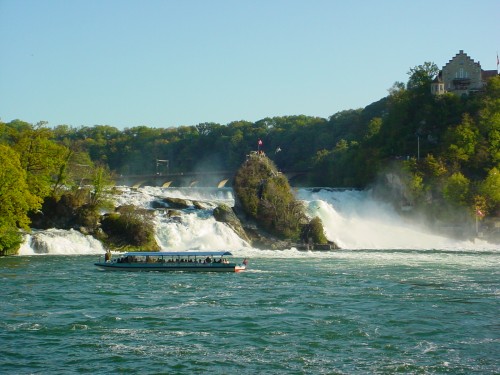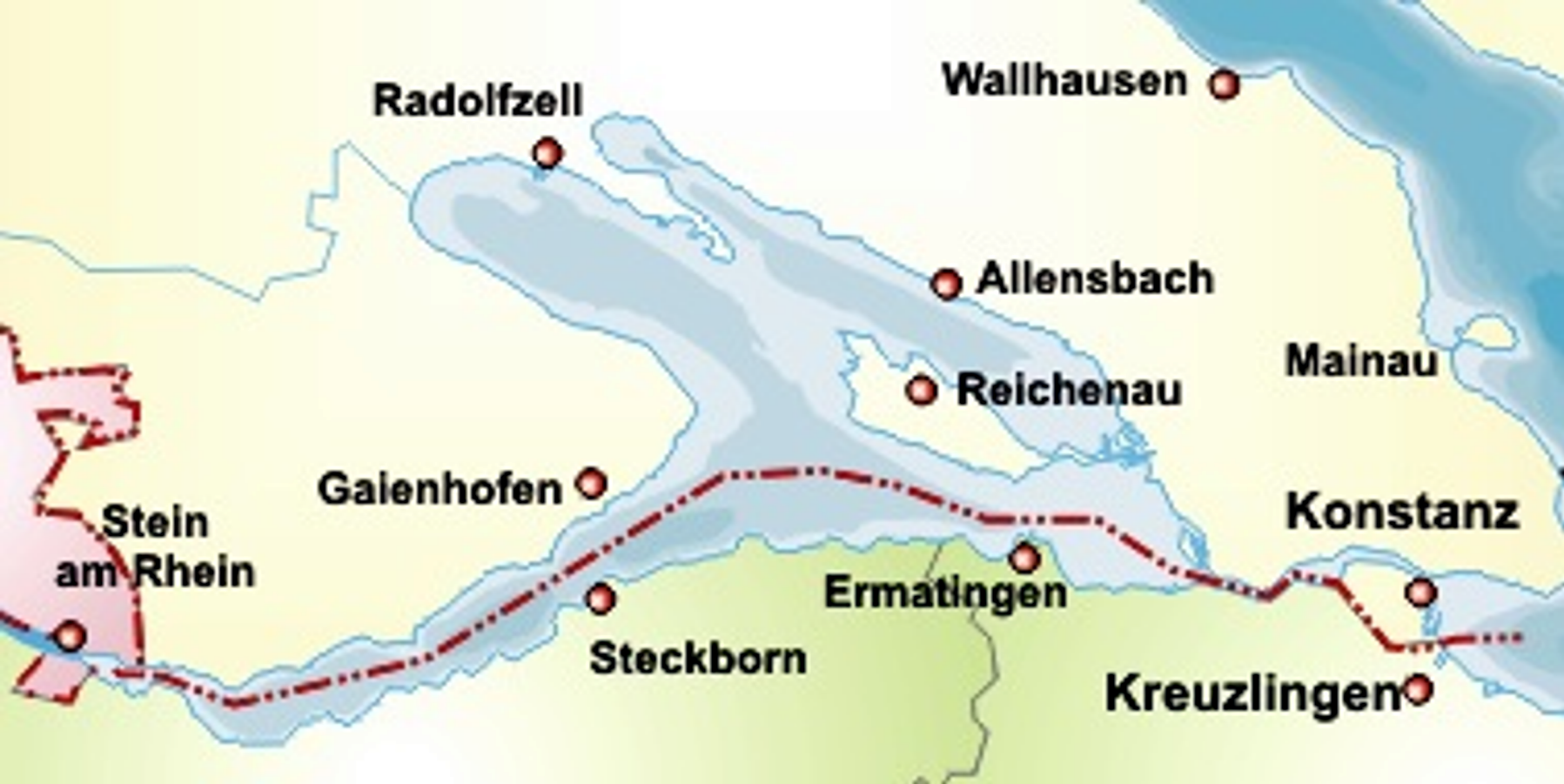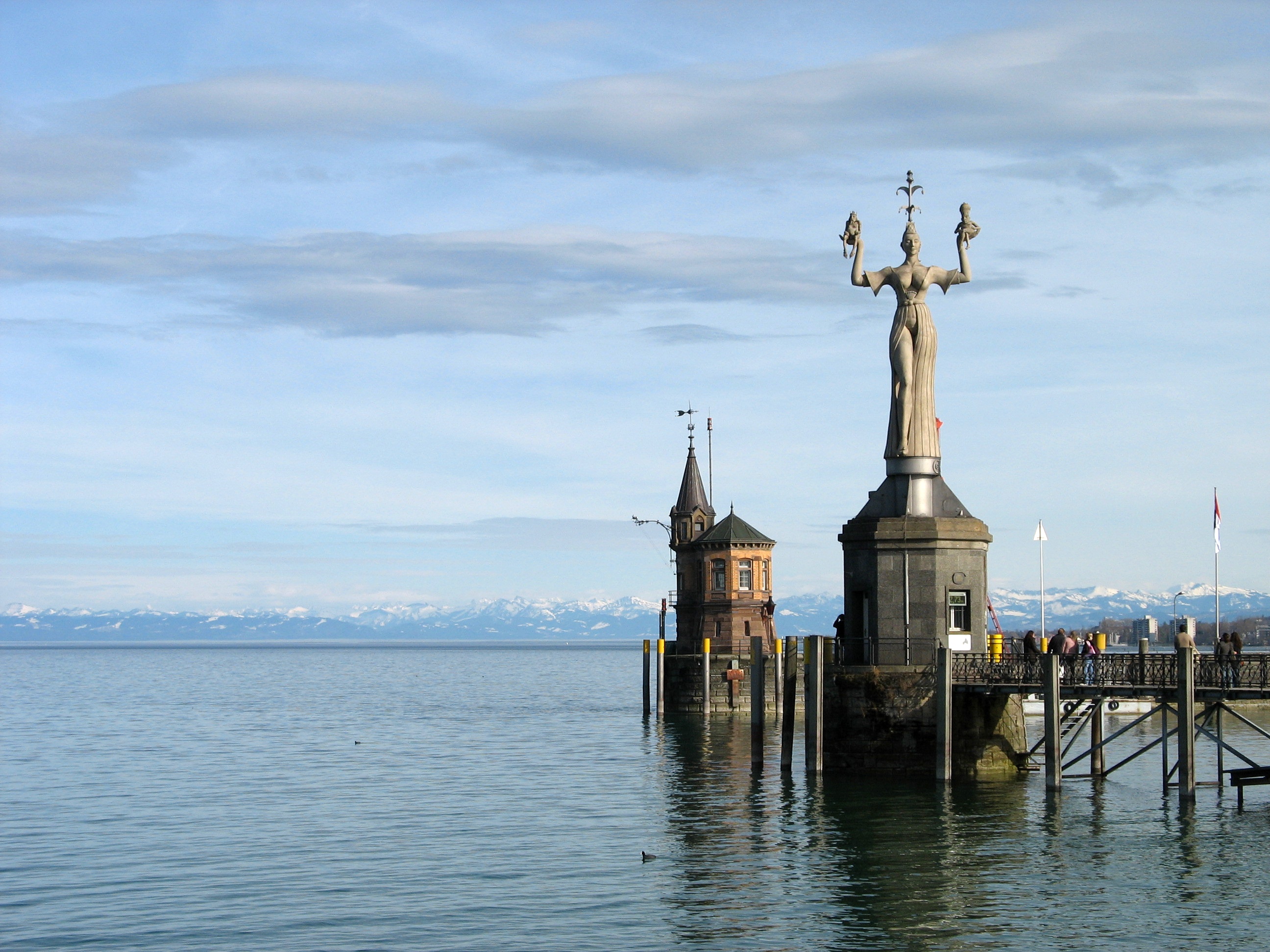|
Reichenau, Baden-Württemberg
Reichenau is a municipality in the district of Konstanz in Baden-Württemberg in Germany. It is located partly on Reichenau Island with its famous abbey and on the northern shore of the ''Untersee'' section of Lake Constance. The island has historically been the center of the community. The administrative seat of the municipality is in the village of ''Mittelzell''. A causeway built in 1838 connects the isle with the mainland. The municipality consists of the settlements ''Niederzell'', ''Mittelzell'' und ''Oberzell'' on the island as well as ''Lindenbühl'' and ''Waldsiedlung'' on the shore. The municipality encompasses the estates of the former Reichenau Abbey, which was secularized in 1757. Today Reichenau is characterized by the market gardening of fruits and vegetables and also known for its psychiatric hospital, established in 1913, a teaching hospital of the University of Konstanz. Reichenau can be reached via the Bundesstraße 33 running from the Bundesautobahn 81 to K ... [...More Info...] [...Related Items...] OR: [Wikipedia] [Google] [Baidu] |
Konstanz (district)
Konstanz (or ''Constance'') is a ''Landkreis'' (district) in the south of Baden-Württemberg on the German-Swiss border, situated along the shores of Lake Constance. Neighboring districts are (from west clockwise) Schwarzwald-Baar, Tuttlingen, Sigmaringen and Bodenseekreis. To the south it borders the Swiss cantons of Zurich, Thurgau and Schaffhausen. The municipality of Büsingen am Hochrhein is an exclave of Germany surrounded by Swiss territory. History The district dates back to the ''Bezirksamt Konstanz'', which was created in 1806 when the area became part of Württemberg (since 1810 Baden). After some changes in its outline it was changed into the district in 1936, including part of the dissolved ''Bezirksamt Engen''. 1939 the city Constance became district-free, but was reintegrated into the district in 1953. 1973 it was merged with the neighboring district Stockach and some municipalities from the districts Sigmaringen and Donaueschingen. Geography The district is ... [...More Info...] [...Related Items...] OR: [Wikipedia] [Google] [Baidu] |
Bundesautobahn 81
is a motorway in Germany. It branches off the A 3 at the Würzburg-West triangle and ends near the border with Switzerland. The oldest part of the A 81 between the Weinsberg intersection ( A 6) near Heilbronn and Dreieck Leonberg ( A 8) near Stuttgart was finished in the years 1938 to 1940. This section included the first tunnel built for an autobahn, the first Engelberg tunnel near Leonberg. When Weinsberg-Leonberg was upgraded to 3+3 lanes in the 1970s, the tunnel with its two lanes each and steep grades (up to 6%) became something of a bottleneck. In 1999 a new Engelberg tunnel was opened. Original plans called for the A 81 to be continued northwards skirting the north-west of Würzburg to join up with the A 7, but these plans were later abandoned. Instead, the A 81 shares a part of the A 8 to the Stuttgart intersection and then continues south on a motorway that was built as A 831 to Gärtringen, where it meets the orig ... [...More Info...] [...Related Items...] OR: [Wikipedia] [Google] [Baidu] |
Schaffhausen
Schaffhausen (; ; ; ; ), historically known in English as Shaffhouse, is a list of towns in Switzerland, town with historic roots, a municipalities of Switzerland, municipality in northern Switzerland, and the capital of the canton of Schaffhausen, canton of the same name; it has an estimated population of 36,000 It is located right next to the shore of the High Rhine; it is one of four Swiss towns located entirely on the northern side of the Rhine, along with , the historic , and . The old town has many fine Renaissance era buildings decorated with exterior frescos and sculpture, as well as the old canton fortress, the ''Munot'' above the old town. Schaffhausen railway station is a junction of Swiss and German railway lines. Rheinfall railway, One of the lines connects the town with the nearby Rhine Falls in , Europe s largest waterfall and a popular Tourism in Switzerland, tourist attraction. The official language of Schaffhausen is (the Swiss variety of Standard) Swiss St ... [...More Info...] [...Related Items...] OR: [Wikipedia] [Google] [Baidu] |
Untersee (Lake Constance)
The ''Untersee'' (German language, German for ''Lower Lake''), also known as Lower Lake Constance, is the smaller of the two lakes that together form Lake Constance. The boundary between Switzerland and Germany runs through it. The lake surrounds several islands, the largest being Reichenau Island. Geography The Lower Lake Constance measures and is situated about lower than the Obersee (Lake Constance), Obersee. The Roman Empire, Romans called it ''Lacus Acronius''. In the Middle Ages, the Upper Lake was called ''Bodamicus Lacus'', or ''Bodensee'' in German. At some point in time, this term began to include the Lower Lake, and a new term "Upper Lake" (in German: ''Obersee (Lake Constance), Obersee''), was introduced for the larger lake. The main tributaries are the ''Seerhein'' and Radolfzeller Aach. The source of the latter is the Aachtopf, a karst spring whose waters mainly derive from the Danube Sinkhole, making the Danube indirectly a tributary of ''Untersee'' and ... [...More Info...] [...Related Items...] OR: [Wikipedia] [Google] [Baidu] |
High Rhine
High Rhine (, ; kilometres 0 to 167 of the Rhine) is the section of the Rhine between Lake Constance () and the city of Basel, flowing in a general east-to-west direction and forming mostly the Germany–Switzerland border. It is the first of four named sections of the Rhine (High Rhine, Upper Rhine, Middle Rhine, Lower Rhine) between Lake Constance and the Rhine–Meuse–Scheldt delta, river delta at the North Sea. Name The term ''High Rhine'' was introduced by scientists in the 19th century. Above all geologists tried to differentiate the High Rhine () linguistically from the Upper Rhine (, ). Until the 19th century, it was also known as the 'Badisch-Swiss Rhine'. It lends its name to the High Rhine Railway line, which to a great extend follows the river to the north of it. Geography Course The High Rhine begins at the outflow of the Rhine from the ''Untersee (Lake Constance), Untersee'' (Lower Lake Constance) in Stein am Rhein and turns into the Upper Rhine at the Rhine knee ... [...More Info...] [...Related Items...] OR: [Wikipedia] [Google] [Baidu] |
Schweizerische Schifffahrtsgesellschaft Untersee Und Rhein
The ''Schweizerische Schifffahrtsgesellschaft Untersee und Rhein AG'' (commonly abbreviated to URh), , is an ''Aktiengesellschaft'' (AG) based in the Swiss town of Schaffhausen. It operates regular boat lines (spring–autumn) between Schaffhausen and Kreuzlingen over the scenic High Rhine () and western part of Lake Constance (). The company was founded in 1850 as the (Swiss paddle steamer corporation). After stopping all operations in 1863, it resumed operations in 1864 under its new name (). The company runs under its current name since 1936. Route The (URh) operates on the upper part of the High Rhine and the western part of Lake Constance. These water bodies largely correspond to the Germany–Switzerland border. A full journey (Schaffhausen–Kreuzlingen) takes ca. 3 hours 45 min. The URh serves landing stages in the following towns and cities in both Switzerland and Germany (an asterisk, * designates relatively close railway stations to the landing stage): * Schaff ... [...More Info...] [...Related Items...] OR: [Wikipedia] [Google] [Baidu] |
Landing Stage
A pier is a raised structure that rises above a body of water and usually juts out from its shore, typically supported by piles or pillars, and provides above-water access to offshore areas. Frequent pier uses include fishing, boat docking and access for both passengers and cargo, and oceanside recreation. Bridges, buildings, and walkways may all be supported by architectural piers. Their open structure allows tides and currents to flow relatively unhindered, whereas the more solid foundations of a quay or the closely spaced piles of a wharf can act as a breakwater, and are consequently more liable to silting. Piers can range in size and complexity from a simple lightweight wooden structure to major structures extended over . In American English, a pier may be synonymous with a dock. Piers have been built for several purposes, and because these different purposes have distinct regional variances, the term ''pier'' tends to have different nuances of meaning in different parts ... [...More Info...] [...Related Items...] OR: [Wikipedia] [Google] [Baidu] |
Museum Reichenau IMG 1160
A museum is an institution dedicated to displaying or preserving culturally or scientifically significant objects. Many museums have exhibitions of these objects on public display, and some have private collections that are used by researchers and specialists. Museums host a much wider range of objects than a library, and they usually focus on a specific theme, such as the arts, science, natural history or local history. Public museums that host exhibitions and interactive demonstrations are often tourist attractions, and many draw large numbers of visitors from outside of their host country, with the most visited museums in the world attracting millions of visitors annually. Since the establishment of the earliest known museum in ancient times, museums have been associated with academia and the preservation of rare items. Museums originated as private collections of interesting items, and not until much later did the emphasis on educating the public take root. Etymology The ... [...More Info...] [...Related Items...] OR: [Wikipedia] [Google] [Baidu] |
Basel
Basel ( ; ), also known as Basle ( ), ; ; ; . is a city in northwestern Switzerland on the river Rhine (at the transition from the High Rhine, High to the Upper Rhine). Basel is Switzerland's List of cities in Switzerland, third-most-populous city (after Zurich and Geneva), with 177,595 inhabitants within the city municipality limits. The official language of Basel is Swiss Standard German and the main spoken language is the local Basel German dialect. Basel is commonly considered to be the cultural capital of Switzerland and the city is famous for its many Museums in Basel, museums, including the Kunstmuseum Basel, Kunstmuseum, which is the first collection of art accessible to the public in the world (1661) and the largest museum of Swiss art, art in Switzerland, the Fondation Beyeler (located in Riehen), the Museum Tinguely and the Museum of Contemporary Art (Basel), Museum of Contemporary Art, which is the first public museum of contemporary art in Europe. Forty museums ... [...More Info...] [...Related Items...] OR: [Wikipedia] [Google] [Baidu] |
High Rhine Railway
The High Rhine Railway () is a Deutsche Bahn railway line from in the city of Basel to on Lake Constance. It was built by the Grand Duchy of Baden State Railways as part of the Baden Mainline, which follows the Rhine upstream from Mannheim Hauptbahnhof to Konstanz. The line derives its name from the High Rhine (), which it follows between Basel and Waldshut and on a short section in Schaffhausen. The line crosses the Germany–Switzerland border three times and passes through Swiss territory two times within the canton of Basel-Stadt and whilst crossing the main part of the canton of Schaffhausen. The other sections of the line run through the German state of Baden-Württemberg. station is congruemtly owned by Deutsche Bahn (DB) and SBB Infrastructure, while the line is operated throughout by DB, and parts by SBB GmbH and Thurbo. History The High Rhine Railway was opened on 4 February 1856 from Basel Bad Bf to Bad Säckingen and extended to Waldshut on 30 October 185 ... [...More Info...] [...Related Items...] OR: [Wikipedia] [Google] [Baidu] |
Konstanz
Konstanz ( , , , ), traditionally known as Constance in English, is a college town, university city with approximately 83,000 inhabitants located at the western end of Lake Constance in the Baden-Württemberg state of south Germany. The city houses the University of Konstanz and was the residence of the Roman Catholic Diocese of Konstanz for more than 1,200 years. Location The city is located in the state of Baden-Württemberg and situated at the banks of Lake Constance (''Bodensee'' in German). The river Rhine, which starts in the Swiss Alps, passes through Lake Constance and leaves it, considerably larger, by flowing under a bridge connecting the two parts of the city. North of the river lies the larger part of the city with residential areas, industrial estates, and the University of Konstanz; while south of the river is the old town, which houses the administrative centre and shopping facilities in addition to the ''Hochschule'' or the ''University of Applied Sciences''. C ... [...More Info...] [...Related Items...] OR: [Wikipedia] [Google] [Baidu] |
Bundesstraße
''Bundesstraße'' (, ), abbreviated ''B'', is the denotation for German and Austrian national highways. Germany Germany's ''Bundesstraßen'' network has a total length of about 40,000 km. German ''Bundesstraßen'' are labelled with rectangular yellow signs with black numerals, as opposed to the white-on-blue markers of the '' Autobahn'' controlled-access highways. ''Bundesstraßen'', like autobahns (''Autobahnen''), are maintained by the federal agency of the Transport Ministry. In the German highway system they rank below autobahns, but above the '' Landesstraßen'' and '' Kreisstraßen'' maintained by the federal states and the districts respectively. The numbering was implemented by law in 1932 and has overall been retained up to today, except for those roads located in the former eastern territories of Germany. One distinguishing characteristic between German ''Bundesstraßen'' and ''Autobahnen'' is that there usually is a general 100 km/h (62 mph) s ... [...More Info...] [...Related Items...] OR: [Wikipedia] [Google] [Baidu] |









